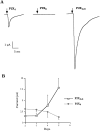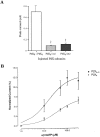Central P2X4 and P2X6 channel subunits coassemble into a novel heteromeric ATP receptor
- PMID: 9736638
- PMCID: PMC6793241
- DOI: 10.1523/JNEUROSCI.18-18-07152.1998
Central P2X4 and P2X6 channel subunits coassemble into a novel heteromeric ATP receptor
Abstract
Ionotropic ATP receptors are widely expressed in mammalian CNS. Despite extensive functional characterization of neuronal homomeric P2X receptors in heterologous expression systems, the subunit composition of native central P2X ATP-gated channels remains to be elucidated. P2X4 and P2X6 are major central subunits with highly overlapping mRNA distribution at both regional and cellular levels. When expressed alone in Xenopus oocytes, P2X6 subunits do not assemble into surface receptors responsive to ATP applications. On the other hand, P2X4 subunits assemble into bona fide ATP-gated channels, slowly desensitizing and weakly sensitive to the partial agonist alpha,beta-methylene ATP and to noncompetitive antagonists suramin and pyridoxal-5-phosphate-6-azophenyl-2',4'-disulfonic acid. We demonstrate here that the coexpression of P2X4 and P2X6 subunits in Xenopus oocytes leads to the generation of a novel pharmacological phenotype of ionotropic ATP receptors. Heteromeric P2X4+6 receptors are activated by low-micromolar alpha, beta-methylene ATP (EC50 = 12 microM) and are blocked by suramin and by Reactive Blue 2, which has the property, at low concentrations, to potentiate homomeric P2X4 receptors. The assembly of P2X4 with P2X6 subunits results from subunit-dependent interactions, as shown by their specific copurification from HEK-293 cells transiently transfected with various epitope-tagged P2X channel subunits. Our data strongly suggest that the numerous cases of neuronal colocalizations of P2X4 and P2X6 subunits observed in mammalian CNS reflect the native expression of heteromeric P2X4+6 channels with unique functional properties.
Figures







Similar articles
-
Characterization of cultured dorsal root ganglion neuron P2X receptors.Eur J Neurosci. 1999 Jan;11(1):149-54. doi: 10.1046/j.1460-9568.1999.00426.x. Eur J Neurosci. 1999. PMID: 9987019
-
Biochemical and functional evidence for heteromeric assembly of P2X1 and P2X4 subunits.J Neurochem. 2005 Feb;92(4):925-33. doi: 10.1111/j.1471-4159.2004.02939.x. J Neurochem. 2005. PMID: 15686495
-
Coexpression of rat P2X2 and P2X6 subunits in Xenopus oocytes.J Neurosci. 2000 Jul 1;20(13):4871-7. doi: 10.1523/JNEUROSCI.20-13-04871.2000. J Neurosci. 2000. PMID: 10864944 Free PMC article.
-
Go it alone no more--P2X7 joins the society of heteromeric ATP-gated receptor channels.Mol Pharmacol. 2007 Dec;72(6):1402-5. doi: 10.1124/mol.107.042077. Epub 2007 Sep 25. Mol Pharmacol. 2007. PMID: 17895406 Review.
-
Pharmacology of cloned P2X receptors.Annu Rev Pharmacol Toxicol. 2000;40:563-80. doi: 10.1146/annurev.pharmtox.40.1.563. Annu Rev Pharmacol Toxicol. 2000. PMID: 10836147 Review.
Cited by
-
Fast synaptic transmission mediated by P2X receptors in CA3 pyramidal cells of rat hippocampal slice cultures.J Physiol. 2001 Aug 15;535(Pt 1):115-23. doi: 10.1111/j.1469-7793.2001.t01-1-00115.x. J Physiol. 2001. PMID: 11507162 Free PMC article.
-
Local regulation of [(3)H]-noradrenaline release from the isolated guinea-pig right atrium by P(2X)-receptors located on axon terminals.Br J Pharmacol. 2000 Dec;131(8):1775-83. doi: 10.1038/sj.bjp.0703757. Br J Pharmacol. 2000. PMID: 11139458 Free PMC article.
-
Expression of P2X receptors on immune cells in the rat liver during postnatal development.Histochem Cell Biol. 2006 Oct;126(4):453-63. doi: 10.1007/s00418-006-0180-7. Epub 2006 Apr 13. Histochem Cell Biol. 2006. PMID: 16612582
-
In the line-up: deleted genes associated with DiGeorge/22q11.2 deletion syndrome: are they all suspects?J Neurodev Disord. 2019 Jun 7;11(1):7. doi: 10.1186/s11689-019-9267-z. J Neurodev Disord. 2019. PMID: 31174463 Free PMC article. Review.
-
Extracellular zinc and ATP-gated P2X receptor calcium entry channels: New zinc receptors as physiological sensors and therapeutic targets.Purinergic Signal. 2005 Dec;1(4):299-310. doi: 10.1007/s11302-005-0777-7. Epub 2005 Dec 3. Purinergic Signal. 2005. PMID: 18404515 Free PMC article.
References
-
- Bo X, Burnstock G. Distribution of [3H]α,β-methylene ATP binding sites in rat brain and spinal cord. NeuroReport. 1994;5:1601–1604. - PubMed
-
- Bo X, Zhang Y, Nassar M, Burnstock G, Schoepfer R. A P2X purinoceptor cDNA conferring a novel pharmacological profile. FEBS Lett. 1995;375:129–133. - PubMed
-
- Brake AJ, Wagenbach MJ, Julius D. New structural motif for ligand-gated ion channels defined by an ionotropic ATP receptor. Nature. 1994;371:519–523. - PubMed
-
- Buell G, Collo G, Rassendren F. P2X receptors: an emerging channel family. Eur J Neurosci. 1996;8:2221–2228. - PubMed
Publication types
MeSH terms
Substances
LinkOut - more resources
Full Text Sources
Other Literature Sources
Miscellaneous
